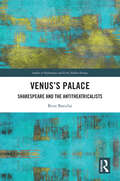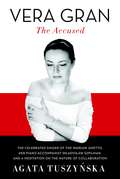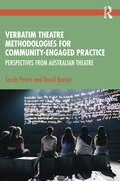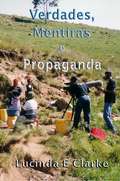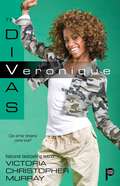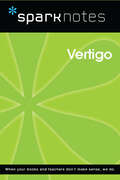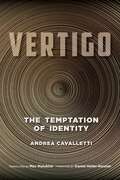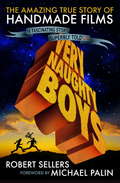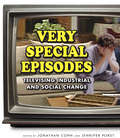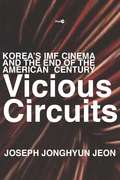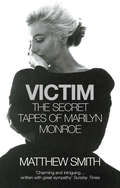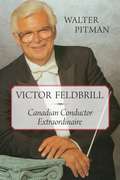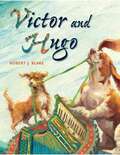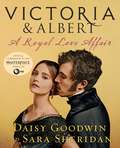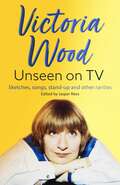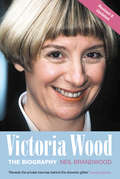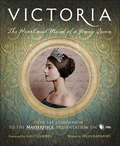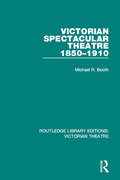- Table View
- List View
Venus’s Palace: Shakespeare and the Antitheatricalists (Studies in Performance and Early Modern Drama)
by Reut BarzilaiThis book lays bare the dialogue between Shakespeare and critics of the stage, and positions it as part of an ongoing cultural, ethical, and psychological debate about the effects of performance on actors and on spectators. In so doing, the book makes a substantial contribution both to the study of representations of theatre in Shakespeare’s plays and to the understanding of ethical concerns about acting and spectating—then, and now. The book opens with a comprehensive and coherent analysis of the main early modern English anxieties about theatre and its power. These are read against 20th- and 21st-century theories of acting, interviews with actors, and research into the effects of media representation on spectator behaviour, all of which demonstrate the lingering relevance of antitheatrical claims and the personal and philosophical implications of acting and spectating. The main part of the book reveals Shakespeare’s responses to major antitheatrical claims about the powerful effects of poetry, music, playacting, and playgoing. It also demonstrates the evolution of Shakespeare’s view of these claims over the course of his career: from light-hearted parody in A Midsummer Night’s Dream, through systematic contemplation in Hamlet, to acceptance and dramatization in The Tempest. This study will be of great interest to scholars and students of theatre, English literature, history, and culture.
Vera Gran: The Accused
by Agata TuszyñskaThe extraordinary, controversial story of Vera Gran, beautiful, exotic prewar Polish singing star; legendary, sensual contralto, Dietrich-like in tone, favorite of the 1930s Warsaw nightclubs, celebrated before, and during, her year in the Warsaw Ghetto (spring 1941-summer 1942) . . . and her piano accompanist: W³adys³aw Szpilman, made famous by Roman Polanski's Oscar-winning film The Pianist, based on Szpilman's memoir.Following the war, singer and accompanist, each of whom had lived the same harrowing story, were met with opposing fates: Szpilman was celebrated for his uncanny ability to survive against impossible odds, escaping from a Nazi transport loading site, smuggling in weapons to the Warsaw Ghetto for the Jewish resistance. Gran was accused of collaborating with the Nazis; denounced as a traitor, a "Gestapo whore," reviled, imprisoned, ultimately exonerated yet afterward still shunned as a performer . . . in effect, sentenced to death without dying . . . until she was found by Agata Tuszyñska, acclaimed poet and biographer of, among others, Isaac Bashevis Singer, Nobel laureate ("Her book has few equals"--The Times Literary Supplement).Tuszyñska, who won the trust of the once-glamorous former singer, then living in a basement in Paris--elderly, bitter, shut away from the world--encouraged Gran to tell her story, including her seemingly inexplicable decision to return to Warsaw to be reunited with her family after she had fled Hitler's invading army, knowing she would have to live within the ghetto walls and, to survive, continue to perform at the popular Café Sztuka.At the heart of the book, Gran's complex, fraught relationship with her accompanist, performing together month after month, for the many who came from within the ghetto and outside its walls to hear her sing.Using Vera Gran's reflections and memories, as well as archives, letters, statements, and interviews with Warsaw Ghetto historians and survivors, Agata Tuszyñska has written an explosive, resonant portrait of lives lived inside a nightmare time, exploring the larger, more profound question of the nature of collaboration, of the price of survival, and of the long, treacherous shadow cast in its aftermath.
Verbatim Theatre Methodologies for Community Engaged Practice: Perspectives from Australian Theatre
by David Burton Sarah PetersVerbatim Theatre Methodologies for Community-Engaged Practice offers a framework for developing original community-engaged productions using a range of verbatim theatre approaches. This book's methodologies offer an approach to community-engaged productions that fosters collaborative artistry, ethically nuanced practice, and social intentionality. Through research-based discussion, case study analysis, and exercises, it provides a historical context for verbatim theatre; outlines the ethics and methods for community immersion that form the foundation of community-engaged best practice; explores the value of interviews and how to go about them; provides clear pathways for translating gathered data into an artistic product; and offers rehearsal room strategies for playwrights, producers, directors, and actors in managing the specific context of the verbatim theatre form. Based on diverse, real-world practice that spans regional, metropolitan, large-scale, micro, independent, commercial, and curriculum-based work, this is a practical and accessible guide for undergraduates, artists, and researchers alike.
Verdad, Mentiras y Propaganda
by Lucinda E Clarke José A Herrera REste libro describe la primera parte de mi viaje desde ser maestra de escuela primaria, pasando por anunciante en radio, luego escritora de libretos para radio hasta llegar a producir para televisión. Todas las historias son verídicas, aunque algunos nombres han sido cambiados para proteger a los personajes más interesantes. Si alguna vez se han preguntado qué ocurre detrás de las cámaras, este libro les brindará algunos secretos y les explicará cómo se hacen los programas de TV. ¿Cómo se siente trabajar con gente famosa, o entrevistarles cuando no les interesa hablarte? No se dejen engañar con eso de que trabajar en televisión es glamoroso. No lo es. Yo pasé más tiempo en baños y husmeando entre montañas de basura que en salas de banquete. Hacer cualquier tipo de programa de TV es un trabajo de equipo, y yo he trabajado con los mejores equipos de grabación y el mejor personal de estudio en Sudáfrica. Sin ellos y sin su pasión, no podría orgullosamente recordar nada de lo que produjimos. Este libro es para ellos y los clientes que nos dieron la confianza de relatar sus historias. Es también para mi esposo que sufre desde hace tiempo y cuya paciencia mientras escribo este libro ha resistido nuevos límites. No hay dos días que sean iguales en el mundo de los medios de comunicación y yo me siento privilegiada de haber sido parte de ello. Pero no crean todo lo que ven en la televisión. Probablemente, ¡es más sabio no creer en absolutamente nada! España 2014
Verdades, Mentiras e Propaganda
by Lucinda E Clarke Talita Mahfuz AdamoEmbora Lucinda sonhasse ser escritora, obediente, ela estudou para ser professora e obter um emprego “adequado”. Seu primeiro contato com a mídia foi através do trabalho no Serviço de Língua Inglesa em Benghazi, na Líbia. Infelizmente, depois disso, ela voltou às salas de aula. Ela não imaginava que perder o emprego de professora e fazer fiasco numa audição para a SABC a teria levado a escrever roteiros de rádio sobre gado doméstico, sobre o qual ela não sabia absolutamente nada. Assim, começou a sua jornada através da escritura, pré-produção e direção de programas sobre diversos assuntos. O que você vê na televisão, às vezes tem pouca relação com a verdade. Esta coleção de acontecimentos far-lhe-á rir e chorar. Ela retira a máscara da mídia e revela a verdade.
Verdi: His Music, Life and Times
by George MartinThis book relates the life and experiences of composer Giuseppe Verdi, from his birth in 1813 to his death in 1901. Besides documenting Verdi's life and the music he created, it also goes further in discussing the times and culture in which he was living in 19th century Italy, both socially and politically.
Verhüllung und Entblößung: Vom erzählenden Text:il zur filmischen Haut als Erfahrungsraum affektiver Identitätsentfaltung
by Anke SteinbornDieses Buch enthält eine interdisziplinäre Betrachtung zum identitätsbildenden Wechselspiel von Text, Textilem und der Haut im und über den Film. Kernthese ist die Überlegung, dass sich im Film über den Wechsel zwischen Textilem und nackter Haut ikonische Verdichtungen zugunsten eines assoziativen Erfahrungsraums entfalten. Dabei weicht der Stoff – der erzählerische gleichermaßen wie der textile – dem Sinnlichen, der Affizierung über die Haut. Die Untersuchung beleuchtet den Zusammenhang zwischen filmischer Rezeption und Selbstreflexion der Zuschauenden, aber auch einer Gesellschaft sowie des Films selbst im jeweils zeitlichen Kontext. Die Filmsehenden erfahren nicht nur das Geschehen und die Protagonist*innen, sondern vor allem auch sich selbst im Spiegel des Anderen – der anderen Figur, der anderen Geschichte, der anderen, filmischen Welt. Ziel der Untersuchung ist es, unter symbolische Hüllen zu schauen und das Wesentliche darunter zu entdecken. Durch die Interdisziplinarität der Arbeit werden nicht nur Interessierte der Film-, Medien- und Kulturwissenschaft, sondern auch der Soziologie, der Psychologie, des (Mode-)Designs, der Kunstgeschichte und der Architektur angesprochen. Das Buch regt zu Perspektivwechseln und interdisziplinärem Austausch auf der Basis der für uns alle existenziellen Haut an. Mit diesem Alleinstellungsmerkmal werden Grenzen überwunden und Kollaborationen angeregt.
Veronique: Veronique (The Divas)
by Victoria Christopher MurrayFrom the bestselling author of The Personal Librarian comes the third in the The Divas series following the stories of four fifteen-year-old girls who form their own singing group.Veronique wants to be a star just as much as her fellow Divas do, but there's more to it than just fame for her. Unlike her middle-class friends at Holy Cross Prep, Veronique is there on scholarship, and if she wins a recording contract, she can move her mother and brothers out of their crummy apartment. But Veronique has another dream that's hers alone. She longs to meet her dad, who disappeared to New York when she was just a baby. Could going to the Big A with the other Divas be Veronique's big chance to find him? Veronique knows she'll have to do some legwork on her own, though, so she turns to the internet for help. While it seems like a miracle when she gets a response, her friends aren't so sure. Is Veronique putting herself in danger, just when the Divas are on the brink of really making it big? And will her faith and her friends be enough to keep her safe?
Verschwörungsideologien in Filmen und Serien: Erklärungsansätze und Chancen zur Intervention
by Denis Newiak Anastasia SchnitzerCorona als inszeniertes Unterdrückungsinstrument, geheim gehaltene Impftote oder kinderbluttrinkende Politiker: Spätestens seit dem Ausbruch der Covid-19-Pandemie haben Verschwörungsideologien Hochkonjunktur und schaden durch ihren Dogmatismus dem sozialen Frieden und der demokratischen Willensbildung. Sogenannte Verschwörungstheorien (conspiracy theories) erzeugen systematisches Misstrauen gegenüber den legitimierten politischen Institutionen und können zu gesellschaftlicher Polarisierung, gefährlichem Populismus und extremistischer Eskalierung beitragen. In Kinofilmen und Fernsehserien waren Verschwörungsideologien schon immer Thema, setzen sie sich doch durch ihre filmischen Mittel seit jeher mit der Beziehung zwischen Realität und Illusion, Wahrheit und Fiktion, Wirklichkeit und Traum, Sinn und Wahnsinn auseinander. Serien und Filme dienen dabei nicht nur als Diskursraum gesellschaftlicher Selbstverständigung, sondern unterbreiten auch durch ihre komplexen Narrative, Figurenkonstellationen und Ästhetiken eingängige Erklärungsansätze für das Entstehen und die Verbreitung von Verschwörungserzählungen. Zugleich unterbreiten sie dabei zum Teil erstaunlich konkrete Vorschläge zur Handhabung solcher kollektiver Wahnvorstellungen. Was können wir aus den fiktionalen Welten von Serien und Filmen für den Umgang mit diesem ganz realen Gegenwartsphänomen lernen?
Vertigo (SparkNotes Film Guide)
by SparkNotesVertigo (SparkNotes Film Guide) Making the reading experience fun! SparkNotes Film Guides are one-stop guides to great works of film–masterpieces that are the foundations of filmmaking and film studies. Inside each guide you&’ll find thorough, insightful overviews of films from a variety of genres, styles, and time periods. Each film guide contains:Information about the director and the context in which the film was made Thoughtful analysis of major characters Details about themes, motifs, and symbols Explanations of the most important lines of dialogue In-depth discussions about what makes a film so remarkable SparkNotes Film Guides are an invaluable resource for students or anyone who wants to gain a deeper understanding of the great films they know and love.
Vertigo: The Temptation of Identity
by Andrea CavallettiReading philosophy through the lens of Alfred Hitchcock’s Vertigo, Andrea Cavalletti shows why, for two centuries, major philosophers have come to think of vertigo as intrinsically part of philosophy itself.Fear of the void, terror of heights: everyone knows what acrophobia is, and many suffer from it. Before Freud, the so-called “sciences of the mind” reserved a place of honor for vertigo in the domain of mental pathologies. The fear of falling—which is also the fear of giving in to the temptation to let oneself fall—has long been understood as a destabilizing yet intoxicating element without which consciousness itself was inconceivable. Some went so far as to induce it in patients through frightening rotational therapies.In a less cruel but no less radical way, vertigo also staked its claim in philosophy. If Montaigne and Pascal could still consider it a perturbation of reason and a trick of the imagination which had to be subdued, subsequent thinkers stopped considering it an occasional imaginative instability to be overcome. It came, rather, to be seen as intrinsic to reason, such that identity manifests itself as tottering, kinetic, opaque and, indeed, vertiginous.Andrea Cavalletti’s stunning book sets this critique of stable consciousness beside one of Hitchcock’s most famous thrillers, a drama of identity and its abysses. Hitchcock’s brilliant combination of a dolly and a zoom to recreate the effect of falling describes that double movement of “pushing away and bringing closer” which is the habitual condition of the subject and of intersubjectivity. To reach myself, I must see myself from the bottom of the abyss, with the eyes of another. Only then does my “here” flee down there and, from there, attract me.From classical medicine and from the role of imagination in our biopolitical world to the very heart of philosophy, from Hollywood to Heidegger’s “being-toward-death,” Cavalletti brings out the vertiginous nature of identity.
Very Naughty Boys [EBK]
by Robert SellersThe incredible, hilarious insider's story of Britain's favourite film company! It all started when Beatle George Harrison stepped in to fund Life of Brian when Monty Python's original backers pulled out. His company, HandMade films, went on to make some of the best British films of the 80s (Withnail and I, Time Bandits and Mona Lisa among them), but then things started to go wrong... This is the incredible and often hilarious insiders' story of what happened...
Very Special Episodes: Televising Industrial and Social Change
by Jonathan Cohn Ron Becker Christine Becker David Scott Diffrient Brett Mills Jorie Lagerwey Mimi White Taylor Nygaard Reba Wissner Jennifer Porst Philip Scepanski Barbara Selznick Lindsay Giggey Erin Copple Smith Erin Giannini Apryl AlexanderVery Special Episodes examines how the quintessential “very special episode” format became a primary way in which the television industry responded to and shaped social change, cultural traumas, and industrial transformations. With essays covering shows ranging from the birth of Desi Arnaz, Jr. on I Love Lucy to contemporary examples such as a delayed episode of Black-ish and the streaming-era phenomenon of the “Very Special Seasons” of UnReal and 13 Reasons Why, this collection seriously and critically uses the “very special episode” to chart the history of American television and its self-identified status as an arbiter of culture.
Vicarious Kinks
by Ummni KhanWho decides where "normal" stops and "perverse" begins? In Vicarious Kinks, Ummni Khan looks at the mass of claims that film, feminism, the human sciences, and law make about sadomasochism and its practitioners, and the way those claims become the basis for the legal regulation of sadomasochist pornography and practice. Khan's audacious proposal is that for film, feminism, law, and science, the constant focus on taboo sexuality is a form of "vicarious kink" itself.Rather than attempt to establish the "truth" about sadomasochism, Vicarious Kinks asks who decides that sadomasochism is perverse, examining how various fields present their claims to truth when it comes to sadomasochism. The first monograph by a new scholar working at the juncture of law and sexuality, Vicarious Kinks challenges the myth of law as an objective adjudicator of sexual truth.
Vicious Circuits: Korea’s IMF Cinema and the End of the American Century (Post*45)
by Joseph Jonghyun JeonIn December of 1997, the International Monetary Fund announced the largest bailout package in its history, aimed at stabilizing the South Korean economy in response to a credit and currency crisis of the same year. Vicious Circuits examines what it terms "Korea's IMF Cinema," the decade of cinema following that crisis, in order to think through the transformations of global political economy at the end of the American century. It argues that one of the most dominant traits of the cinema that emerged after the worst economic crisis in the history of South Korea was its preoccupation with economic phenomena. As the quintessentially corporate art form—made as much in the boardroom as in the studio—film in this context became an ideal site for thinking through the global political economy in the transitional moment of American decline and Chinese ascension. With an explicit focus of state economic policy, IMF cinema did not just depict the economy; it also was this economy's material embodiment. That is, it both represented economic developments and was itself an important sector in which the same pressures and changes affecting the economy at large were at work. Joseph Jonghyun Jeon's window on Korea provides a peripheral but crucial perspective on the operations of late US hegemony and the contradictions that ultimately corrode it.
Victim
by Matthew SmithSuicide? Or murder? Marilyn Monroe's death in August 1962, apparently a suicide, shocked the world. A Hollywood star, a global icon, why would she have killed herself? Yet the coroner's report stated her death was due to a massive overdose of 47 Nembutal capsules. But what about the discrepancies between the official report and the scene of her death? What about the forensic evidence that went missing shortly after she died? Matthew Smith has constructed a startling new version of events. His interpretation is based not only on the full and true forensic evidence from the time, but also on the tapes that Marilyn made for her psychiatrist in the days and weeks before her death, tapes that portray a woman in full charge of her life and looking forward to a bright, busy, successful future. Forty years after her death, Marilyn remains an icon and a mystery. Matthew Smith's investigation into her death will lead to a new understanding of what really happened on the night of August 5th 1962 and in the weeks leading up to it.
Victor Feldbrill: Canadian Conductor Extraordinaire
by Walter PitmanVictor Feldbrill is an account of the life and cultural contribution of one of Canada’s most talented conductors. Born in 1924, he made his Toronto Symphony conducting debut at 18. He went on to become the artistic director of the Winnipeg Symphony, a conductor with the Toronto Symphony, and a guest conductor of virtually every major symphony orchestra in Canada. Feldbrill was also the first conductor-in-residence at the University of Toronto’s Faculty of Music from 1968 to 1982. However, what really set Feldbrill apart was his limitless enthusiasm and support of Canadian music and young musicians, as well as his insistence on playing the music of Canadian composers despite the reluctance of some orchestral managers and the initial opposition of audiences at the time. In doing so he reached out to young people and trained many to take their places as members of Canadian orchestras from coast to coast.
Victor Fleming: An American Movie Master (Screen Classics)
by Michael SragowThis definitive biography chronicles the life and work of the legendary director of Gone With the Wind and The Wizard of Oz.Victor Fleming was the most sought-after director in Hollywood’s golden age, renowned for his work across an astounding range of genres—from gritty westerns to screwball comedies, romances, boddy pictures, and family entertainment. Yet this chameleon-like versatility has resulted in his relative obscurity today—despite his having directed two of the most iconic movies of all time.Fleming is best remembered for Gone With the Wind and The Wizard of Oz, but he directed more than forty films, including classics like Red Dust, Test Pilot, Dr. Jekyll and Mr. Hyde, and Captains Courageous. Fleming created enduring screen personas for Clark Gable, Spencer Tracy, and Gary Cooper, as well as for Ingrid Bergman, Clara Bow, and Norma Shearer—who were among his many lovers.In this definitive biography, Michael Sragow restores the director to the pantheon of great American filmmakers, correcting a major oversight in Hollywood history. It is the dramatic story of a man at the center of the most exciting period in American filmmaking.
Victor and Hugo
by Robert J. BlakeFrom the creator of beloved stories about dogs--their bravery, loyalty, and companionship--comes a celebration of music, friendship, Paris, and puppies set against an exquisitely illustrated Parisian backdrop!On a beautiful bridge in Paris, performing dogs Victor and Hugo dance and sing as their Maestro plays his music. But when Maestro&’s accordion falls over the side of the bridge and onto a barge, the music stops—not only for Maestro, but for everyone! Victor and Hugo must rescue the accordion, and as they chase after it, they know that saving the accordion for their Maestro will mean saving music for the entire city as well. In this rollicking adventure through Paris, Victor and Hugo show us that friendship and music can combine to create the greatest magic of all.Praise for Victor and Hugo:"A high-energy, exuberant romp through the City of Light. For lovers of art, music, and action-packed adventure."--School Library Journal
Victoria & Albert: A Royal Love Affair
by Daisy Goodwin Sara SheridanThe official companion to the second season of the PBS/Masterpiece drama Victoria by award-winning creator and screenwriter Daisy Goodwin.Airing in the Downton Abbey slot on PBS/Masterpiece last January, Victoria captivated millions of viewers, eclipsing Downton's first-season viewership and leaving its audience eager for the series's next season, which will focus on Victoria and Albert's passionate and tempestuous marriage.This official tie-in to the show, by creator and screenwriter Daisy Goodwin, gives a behind-the-scenes look at the making of the show, featuring never-before-seen interviews, photos, diary entries, profiles on all major characters, and sumptuous detail on the costumes and props that bring Victoria and Albert's world to vivid life. Victoria and Albert follows this extraordinary relationship between two very different people—she impulsive, emotional, capricious; he cautious, self-controlled, and logical—whose devotion to each other was unparalleled in royal history. Taking fans deeper into the world of Victoria than ever before, Victoria and Albert: A Royal Love Affair is the ultimate gift for devotees of the show.
Victoria Wood Unseen on TV: Unseen On Tv
by Jasper Rees Victoria Wood'There was none like her before and there's been none like her since' Dawn FrenchIn the five years since Victoria Wood's death, one great sadness has been the realisation that we will never again be surprised by new material from her.But as part of the research for Let's Do It, the critically acclaimed Sunday Times bestseller, her official biographer Jasper Rees uncovered a treasure chest of unseen work. From her first piece of comic prose, for the school magazine, through to material written for the great TV shows of her maturity, this joyful hoard of unreleased material spans nearly half a century.Victoria Wood: Unseen on TV is a unique and intimate insight into the working of an irreplaceable genius of comedy.From the first to the last, here are sketches, songs and stand-up monologues that no one else could have written, which will make you laugh in the way that only she could.'He was a lovely man he had a lovely gap between his two front teeth. I specially noticed it cos he had a mushy pea stuck in it. He said can I take you home I said hang on I haven't finished my Tizer. So, we get home he says can I come in for a coffee. I said I haven't got any coffee but you can come in for a Horlicks if you don't mind sucking your own lumps.'Praise for Let's Do It:'Rees pulls off the trick of writing a brilliant tribute while also - somehow, almost - bringing Victoria Wood back to life in all her complicated glory.' Guardian'An immersive, authoritative book' Spectator'Impeccable' Daily Telegraph'A must-read' Daily Mirror'A joy' Daily Mail
Victoria Wood: The Biography
by Neil Brandwood'One of the great British comedians and all-round entertainers of her generation' Guardian'Bittersweet but scalpel sharp' Radio Times'One of Britain’s finest ever performers ... a sublime and unparalleled crafter of words' Independent Victoria Wood's wit and humour endeared her to millions of TV viewers for over four decades. Writer, producer and actress of television shows such as As Seen on TV and Dinnerladies, Victoria was often voted the funniest woman in Britain. Her rise to stardom, from her early years in Lancashire to the successes of the sell-out shows at the Royal Albert Hall, is sympathetically and honestly portrayed by Neil Brandwood. This meticulously researched and written biography provides an insightful account of the life and career of one of Britain's best-loved comediennes.
Victoria: The Heart and Mind of a Young Queen
by Helen RappaportThe official companion to the Masterpiece series on PBS, exploring the history behind the show.Discover the world of the young Victoria, a world of court drama, sumptuous splendor, and the epic tale of an unexpected queen.At only eighteen years old, Victoria was a rebellious and headstrong teenager when she ascended the throne as Queen of Great Britain, but she grew to become one of the most memorable, unshakable, and powerful women in history. Tracing the coming-of-age of one of Britain’s greatest monarchs, this official companion to the Masterpiece series on PBS reveals her triumphs over scandal and corruption, and the intimate loves, heartbreaking losses, fallouts, and family dramas that accompanied her early reign.Written by internationally bestselling author and Victoria historical consultant Helen Rappaport, and including a foreword by Daisy Goodwin—acclaimed novelist and screenwriter of the series—Victoria details the history behind the show. It includes fascinating letters from the Queen, her family, confidants, and Prince Albert, offering truly authentic insight into the private life of the young Queen and the inner workings of the royal household, and painting a vivid picture of life in Victorian England.Go behind the palace doors and discover the girl behind the Queen, as you’ve never seen her before.Praise for Victoria: The Heart and Mind of a Young Queen “Rappaport’s text beautifully and chronologically guides the reader through the early years of Victoria’s reign . . . This is a volume fans of the Masterpiece series will look at again and again.” —Newark Star Ledger“A marvelous companion to this series, with wonderful illustrations and an engaging backstory . . .”—New York Journal of Books
Victorian Dramatic Criticism (Routledge Library Editions: Victorian Theatre #5)
by George RowellOriginally published in 1971. The Victorian Age was one of popular theatre and increasingly popular journalism. One manifestation of this journalism was the emergence of the dramatic critic from the anonymity and brevity which had previously characterized periodical treatment of the theatre. If Victorian theatre is regarded as existing essentially thirty years before Victoria acceded and continuing until the outbreak of war in 1914, the names of Lamb, Leigh Hunt and Hazlitt at one end, and of Beerbohm and MacCarthy at the other, can be added to a list that includes Lewes, James, Archer, Walkley, Shaw and Montague. All these writers, and others less famous, are represented in this selection. By selecting the articles on the basis of the play in performance, rather than the play as literature, and by arranging them according to various aspects of the theatrical process, this book builds up a skilful and lively picture of the contemporary theatre at work, in the words of its leading commentators. The anthology successfully conveys the qualities of abundance and vitality to characteristic of Victorian theatre.
Victorian Spectacular Theatre 1850-1910 (Routledge Library Editions: Victorian Theatre #3)
by Michael R. BoothOriginally published in 1981. This study concentrates on one aspect of Victorian theatre production in the second half of the nineteenth century – the spectacular, which came to dominate certain kinds of production during that period. A remarkably consistent style, it was used for a variety of dramatic forms, although surrounded by critical controversy. The book considers the theories and practice of spectacle production as well as the cultural and artistic movements that created the favourable conditions in which spectacle could dominate such large areas of theatre for so many years. It also discusses the growth of spectacle and the taste of the public for it, examining the influence of painting, archaeology, history, and the trend towards realism in stage production. An explanation of the working of spectacle in Shakespeare, pantomime and melodrama is followed by detailed reconstructions of the spectacle productions of Irving’s Faust and Beerbohm Tree’s King Henry VIII.
